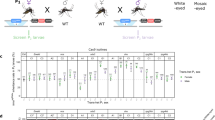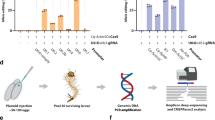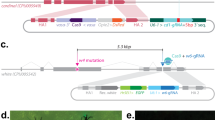Abstract
Current transgenic methodology developed for mosquitoes has not been applied widely to the major malaria vector Anopheles gambiae, which has proved more difficult to genetically manipulate than other mosquito species and dipteran insects. In this protocol, we describe ΦC31-mediated site-specific integration of transgenes into the genome of A. gambiae. The ΦC31 system has many advantages over 'classical' transposon-mediated germline transformation systems, because it allows integration of large transgenes at specific, characterized genomic locations. Starting from a general protocol, we have optimized steps from embryo collection to co-injection of transgene-containing plasmid and in vitro–produced ΦC31 integrase mRNA. We also provide tips for screening transgenic larvae. The outlined procedure provides robust transformation in A. gambiae, resulting in homozygous transgenic lines in ∼2–3 months.
This is a preview of subscription content, access via your institution
Access options
Subscribe to this journal
Receive 12 print issues and online access
$259.00 per year
only $21.58 per issue
Buy this article
- Purchase on Springer Link
- Instant access to full article PDF
Prices may be subject to local taxes which are calculated during checkout







Similar content being viewed by others
Accession codes
References
Dimopoulos, G. et al. Genome expression analysis of Anopheles gambiae: responses to injury, bacterial challenge, and malaria infection. Proc. Natl. Acad. Sci. USA 99, 8814–8819 (2002).
Meister, S. et al. Immune signaling pathways regulating bacterial and malaria parasite infection of the mosquito Anopheles gambiae. Proc. Natl. Acad. Sci. USA 102, 11420–11425 (2005).
Pinto, S.B. et al. Discovery of Plasmodium modulators by genome-wide analysis of circulating hemocytes in Anopheles gambiae. Proc. Natl. Acad. Sci. USA 106, 21270–21275 (2009).
Fontaine, A. et al. Anopheles salivary gland proteomes from major malaria vectors. BMC Genomics 13, 614 (2012).
Choumet, V. et al. The salivary glands and saliva of Anopheles gambiae as an essential step in the Plasmodium life cycle: a global proteomic study. Proteomics 7, 3384–3394 (2007).
Rinker, D.C. et al. Blood meal-induced changes to antennal transcriptome profiles reveal shifts in odor sensitivities in Anopheles gambiae. Proc. Natl. Acad. Sci. USA 110, 8260–8265 (2013).
Bonizzoni, M. et al. Comparative transcriptome analyses of deltamethrin-resistant and -susceptible Anopheles gambiae mosquitoes from Kenya by RNA-seq. PLoS ONE 7, e44607 (2012).
Thailayil, J., Magnusson, K., Godfray, H.C.J., Crisanti, A. & Catteruccia, F. Spermless males elicit large-scale female responses to mating in the malaria mosquito Anopheles gambiae. Proc. Natl. Acad. Sci. USA 108, 13677–13681 (2011).
Butail, S., Manoukis, N.C., Diallo, M., Ribeiro, J.M. & Paley, D.A. The dance of male Anopheles gambiae in wild mating swarms. J. Med. Entomol. 50, 552–559 (2013).
Lombardo, F. et al. An Anopheles gambiae salivary gland promoter analysis in Drosophila melanogaster and Anopheles stephensi. Insect. Mol. Biol. 14, 207–216 (2005).
Catteruccia, F., Benton, J.P. & Crisanti, A. An Anopheles transgenic sexing strain for vector control. Nat. Biotechnol. 23, 1414–1417 (2005).
Catteruccia, F. et al. Toward Anopheles transformation: Minos element activity in anopheline cells, and embryos. Proc. Natl. Acad. Sci. USA 97, 6236 (2000).
Moreira, L.A., Wang, J., Collins, F.H. & Jacobs-Lorena, M. Fitness of Anopheline mosquitoes expressing transgenes that inhibit Plasmodium development. Genetics 166, 1337–1341 (2004).
Isaacs, A.T. et al. Transgenic Anopheles stephensi coexpressing single-chain antibodies resist Plasmodium falciparum development. Proc. Natl. Acad. Sci. USA 109, E1922–E1930 (2012).
Abraham, E.G. et al. An immune-responsive serpin, SRPN6, mediates mosquito defense against malaria parasites. Proc. Natl. Acad. Sci. USA 102, 16327–16332 (2005).
Blandin, S. et al. Reverse genetics in the mosquito Anopheles gambiae: targeted disruption of the Defensin gene. EMBO Rep. 3, 852–856 (2002).
Blandin, S. et al. Complement-like protein TEP1 is a determinant of vectorial capacity in the malaria vector Anopheles gambiae. Cell 116, 661–670 (2004).
Blandin, S.A. et al. Dissecting the genetic basis of resistance to malaria parasites in Anopheles gambiae. Science 326, 147–150 (2009).
Boisson, B. et al. Gene silencing in mosquito salivary glands by RNAi. FEBS Lett. 580, 1988–1992 (2006).
Osta, M.A., Christophides, G.K. & Kafatos, F.C. Effects of mosquito genes on Plasmodium development. Science 303, 2030–2032 (2004).
Catteruccia, F. et al. Stable germline transformation of the malaria mosquito Anopheles stephensi. Nature 405, 959–962 (2000).
Grossman, G.L. et al. Germline transformation of the malaria vector, Anopheles gambiae, with the piggyBac transposable element. Insect. Mol. Biol. 10, 597–604 (2001).
Kim, W. et al. Ectopic expression of a cecropin transgene in the human malaria vector mosquito Anopheles gambiae (Diptera: Culicidae): effects on susceptibility to Plasmodium. J. Med. Entomol. 41, 447–455 (2004).
Lobo, N.F., Clayton, J.R., Fraser, M.J., Kafatos, F.C. & Collins, F.H. High efficiency germ-line transformation of mosquitoes. Nat. Protoc. 1, 1312–1317 (2006).
Benedict, M. Microinjection methods for Anopheles embryos. in Methods in Anopheles Research (http://www.mr4.org/Publications/MethodsinAnophelesResearch.aspx) (MR4, 2007).
Lombardo, F., Lycett, G., Lanfrancotti, A., Coluzzi, M. & Arca, B. Analysis of apyrase 5 upstream region validates improved Anopheles gambiae transformation technique. BMC Research Notes 2, 24 (2009).
Fuchs, S., Nolan, T. & Crisanti, A. Mosquito transgenic technologies to reduce Plasmodium transmission. in Malaria Vol. 923 (ed. Ménard, R.) 601–622 (Humana Press, 2013).
O'Brochta, D.A., Alford, R.T., Pilitt, K.L., Aluvihare, C.U. & Harrell, R.A. piggyBac transposon remobilization and enhancer detection in Anopheles mosquitoes. Proc. Natl. Acad. Sci. 108, 16339–16344 (2011).
O'Brochta, D.A., Pilitt, K.L., Harrell, R.A. II, Aluvihare, C. & Alford, R.T. Gal4-based enhancer-trapping in the malaria mosquito Anopheles stephensi. G3 (Bethesda) 2, 1305–1315 (2012).
Lycett, G.J., Amenya, D. & Lynd, A. The Anopheles gambiae α-tubulin-1b promoter directs neuronal, testes and developing imaginal tissue specific expression and is a sensitive enhancer detector. Insect Mol. Biol. 21, 79–88 (2012).
Franz, A.W.E. et al. Comparison of transgene expression in Aedes aegypti generated by mariner Mos1 transposition and ΦC31 site-directed recombination. Insect Mol. Biol. 20, 587–598 (2011).
Thorpe, H.M. & Smith, M.C. In vitro site-specific integration of bacteriophage DNA catalyzed by a recombinase of the resolvase/invertase family. Proc. Natl. Acad. Sci. USA 95, 5505–5510 (1998).
Meredith, J.M. et al. Site-specific integration and expression of an anti-malarial gene in transgenic Anopheles gambiae significantly reduces Plasmodium infections. PLoS ONE 6, e14587 (2011).
Windbichler, N. et al. A synthetic homing endonuclease-based gene drive system in the human malaria mosquito. Nature 473, 212–215 (2011).
Fish, M.P., Groth, A.C., Calos, M.P. & Nusse, R. Creating transgenic Drosophila by microinjecting the site-specific ΦC31 integrase mRNA and a transgene-containing donor plasmid. Nat. Protoc. 2, 2325–2331 (2007).
Groth, A.C., Fish, M., Nusse, R. & Calos, M.P. Construction of transgenic Drosophila by using the site-specific integrase from phage ΦC31. Genetics 166, 1775–1782 (2004).
Labbé, G.M.C., Nimmo, D.D. & Alphey, L. piggyBac- and ΦC31-mediated genetic transformation of the Asian Tiger Mosquito, Aedes albopictus (Skuse). PLoS Negl. Trop. Dis. 4, e788 (2010).
Smidler, A.L., Terenzi, O., Soichot, J., Levashina, E.A. & Marois, E. Targeted mutagenesis in the malaria mosquito using TALE nucleases. PLoS ONE 8, e74511 (2013).
Shaner, N.C., Steinbach, P.A. & Tsien, R.Y. A guide to choosing fluorescent proteins. Nat. Methods 2, 905–909 (2005).
Nimmo, D.D., Alphey, L., Meredith, J.M. & Eggleston, P. High efficiency site-specific genetic engineering of the mosquito genome. Insect Mol. Biol. 15, 129–136 (2006).
Meredith, J.M., Underhill, A., McArthur, C.C. & Eggleston, P. Next-generation site-directed transgenesis in the malaria vector mosquito Anopheles gambiae: self-docking strains expressing germline-specific ΦC31 integrase. PLoS ONE 8, e59264 (2013).
Bischof, J., Maeda, R.K., Hediger, M., Karch, F.ß. & Basler, K. An optimized transgenesis system for Drosophila using germ-line-specific ΦC31 integrases. Proc. Natl. Acad. Sci. USA 104, 3312–3317 (2007).
Long, D. et al. In vivo site-specific integration of transgene in silkworm via ΦC31 integrase-mediated cassette exchange. Insect Biochem. Mol. Biol. 43, 997–1008 (2013).
Ringrose, L. Transgenesis in Drosophila melanogaster. Methods Mol. Biol. 561, 3–19 (2009).
Horn, C., Schmid, B.G., Pogoda, F.S. & Wimmer, E.A. Fluorescent transformation markers for insect transgenesis. Insect Biochem. Mol. Biol. 32, 1221–1235 (2002).
Perera, O.P., Harrell, I.R. & Handler, A.M. Germ-line transformation of the South American malaria vector, Anopheles albimanus, with a piggyBac/EGFP transposon vector is routine and highly efficient. Insect Mol. Biol. 11, 291–297 (2002).
Lynd, A. & Lycett, G.J. Development of the bi-partite Gal4-UAS system in the African Malaria Mosquito, Anopheles gambiae. PLoS ONE 7, e31552 (2012).
Thyagarajan, B., Olivares, E.C., Hollis, R.P., Ginsburg, D.S. & Calos, M.P. Site-specific genomic integration in mammalian cells mediated by phage ΦC31 integrase. Mol. Cell Biol. 21, 3926–3934 (2001).
Acknowledgements
We are grateful to the Photography Department of Institut Pasteur, especially F. Gardy and J.-M. Panaud for the production of the video for embryo alignment, and to M. Calos for pET11-ΦC31 and original attP and attB constructs. We thank A. James, A. Handler and N. Windbichler for helpful technical discussions. Support to E.P. was from an ANR-07-MIME-O25-01 award to C.B., from the Roux Foundation (Pasteur Institute) and from a UE323173 Anopath award to K.D.V.; to C.B. from award no. ANR-10-LABX-62-IBEID; to P.E. from a Wellcome Trust Programme grant (0084582) and the EU FP7 (INFRAVEC); and to G.J.L. from European Commission grant no. 223726 (TransMalariaBloc) and a Biotechnology and Biological Sciences Research Council grant (no. BB/F021933/1).
Author information
Authors and Affiliations
Contributions
E.P., N.P., J.M.M., A.L. and G.J.L. performed the research; C.B., G.J.L. and P.E. designed and supervised the research; K.D.V. supervised the research; and E.P., A.L., G.J.L., P.E. and C.B. wrote the manuscript.
Corresponding authors
Ethics declarations
Competing interests
The authors declare no competing financial interests.
Supplementary information
Supplementary Table 1
Primers and PCR parameters to detect transgene site-specific integration. (PDF 80 kb)
Supplementary Video 1
Anopheles gambiae embryo alignment for microinjection. (MOV 66430 kb)
Rights and permissions
About this article
Cite this article
Pondeville, E., Puchot, N., Meredith, J. et al. Efficient ΦC31 integrase–mediated site-specific germline transformation of Anopheles gambiae. Nat Protoc 9, 1698–1712 (2014). https://doi.org/10.1038/nprot.2014.117
Published:
Issue Date:
DOI: https://doi.org/10.1038/nprot.2014.117
This article is cited by
-
A transgenic tool to assess Anopheles mating competitiveness in the field
Parasites & Vectors (2018)
Comments
By submitting a comment you agree to abide by our Terms and Community Guidelines. If you find something abusive or that does not comply with our terms or guidelines please flag it as inappropriate.



